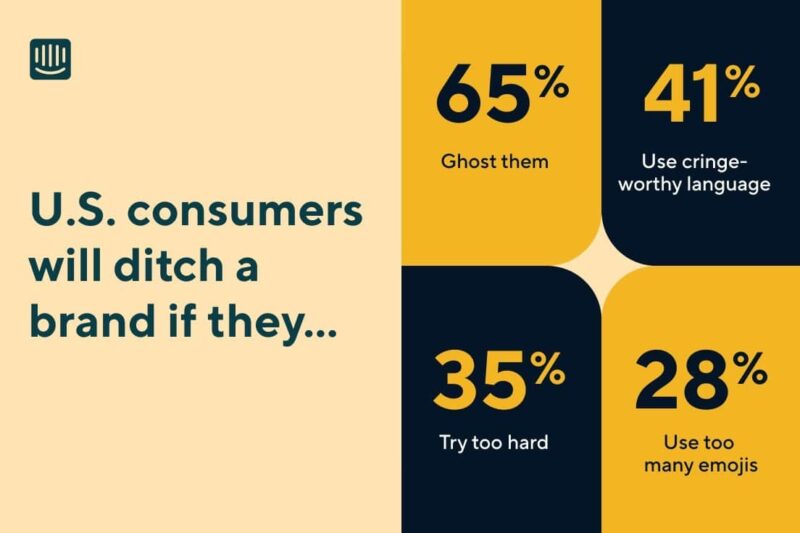Consumers continue to tighten their belts with an uncertain economy, and according to a new study from Intercom, the way that companies talk to their customers can significantly impact retention and business growth.
The study of 1,000 U.S. consumers found that three in four say communication that makes them feel valued is a top or the most important factor when doing business with a brand. In fact, 64% would leave a business if they didn’t feel valued—only falling behind not actually having their issue resolved (66%), and getting ghosted by a support representative (65%). Feeling valued and respected is even more important than getting a quick customer support response (61%).
There are striking generational differences in the style and tone consumers want from businesses. “Good customer support” varies based on the person and situation—making it essential for businesses to deliver personalized communication that is grounded in context and a deep understanding of each individual customer.
Intercom Co-founder and Chief Strategy Officer Des Traynor says:
Consumers have higher expectations for businesses to be transparent, to be present and to be available to connect with. How you talk to customers, where you talk to them, and what you say impact whether or not they continue to give you their business. This study underscores that the best way to keep customers is to make your communication more personal—to show each customer that you know them, understand their issues, and can resolve them in the way they want.

Get personal—but not cringey
Personal and friendly communication strengthens the relationship between businesses and their customers, but how you do it matters. Too much familiarity that doesn’t feel authentic can backfire.
- Tone is key: consumers say disrespecting them (64%), using cringe-worthy language (41%—think misused slang), trying too hard with inauthentic communication (35%) or using too many emojis (28%) in support interactions will cause them to take their business elsewhere.
- Not all emojis are created equal: while 59% of people are OK with companies using emojis in support conversations, they prefer facial expressions over objects. Unsurprisingly, there appears to be a shift here along generational lines: younger generations are twice as likely as older ones to want companies to use emojis and GIFs, signaling a shift in how businesses will need to adapt their support and communication strategies as younger generations become primary buyers.
- Today, most consumers prefer professional (56%) vs. casual language (44%) from companies. However, Gen Z’s growing influence may make informality the norm in the future—61% of Gen Z respondents prefer a more casual approach.
- Knowing a customer’s purchase or usage history is the top way to make them feel valued. 66% of respondents rate it among the top 3 factors that show they are valued, including receiving VIP treatment (52%) and proactive tips and support without needing to initiate a conversation (51%). Surface-level personalization, like using their first name in communications and adding greetings and goodbyes, ranks lowest.
Consumers want short text and direct messages—not dreaded phone tree loops
The ways that consumers want to engage with businesses are changing, with 86% of respondents saying they’re OK with companies communicating in the same way they communicate with their family and friends.
- When asked which ways consumers like connecting with family and friends that they wish businesses would use, respondents across all generations (60%) said communicating by text or direct messages. From Gen Z to Boomers, this is the more welcome approach.
- More than one-third (35%) of respondents also ranked sending a stream of shorter messages instead of longer paragraphs as a top wish. Millennials showed the strongest preference (49%) for this style.
- Automated phone systems are the most disliked channel overall across all respondents, followed closely by live phone calls. Gen Z and Gen X in particular dislike live phone calls even more than the dreaded phone tree.
- Different situations call for different styles of communication. Chatbots and online chat are most preferred for answering a quick question (49%), confirming an appointment or delivery time (37%), or canceling an order (30%), with 79% saying overall, there are times and places where they definitely prefer chatbots and online chat. Only 21% say there’s no circumstance where they would want to interact with a chatbot or online chat—however, this sentiment is higher for Boomers (34%).
- Overall, consumers don’t want to share sensitive information via chat, but Millennials (27%) are more comfortable doing so than their younger and older counterparts.
- Automated customer support tools like chatbots have room to improve. While consumers are split nearly 50/50 on whether they find them aggravating or helpful, more Millennials (65%) find them helpful and easy to use than any other age group. And with disruptive technology like OpenAI’s ChatGPT now available, huge leaps in customer support automation and artificial intelligence are clearly imminent.
The industries providing the best and worst customer support
- When ranking industries, consumers say healthcare and financial services have the best customer support, and their reputation is particularly strong with older generations.
- As travelers struggle with lost baggage and canceled flights during a busy holiday travel season, airlines ranked lowest for customer support satisfaction, with only 6% of respondents rating their customer support experience the best.
- Telecom/mobile and clothing retailers also showed room for improvement.
Traynor added:
Personalized support is crucial for businesses looking to edge over the competition. Consumers choose to spend their money where they feel valued, and how businesses support and talk to them is a huge factor.
Learn more about Intercom: www.intercom.com









